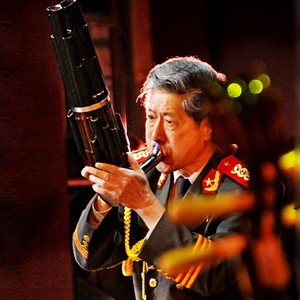
| Trackimage | Playbut | Trackname | Playbut | Trackname |
|---|---|---|---|---|
| 21005750 | Play | Grassland Cavalrymen | 03:45 Tools | |
| 21005751 | Play | The Phoenix Spreading its Wings | 03:58 Tools | |
| 21005752 | Play | The Phoenix Spreading Its Wings (Feng Huang Zhan Chi) | 04:00 Tools | |
| 21005753 | Play | The Fluttering Red Fleg (Hong Qi Zhao Zhan) | 04:34 Tools | |
| 21005754 | Play | Fisherman s Song At South Sea (Nan Hai Yu Ge) | 04:59 Tools | |
| 21005759 | Play | Paean of Petroleum (Shi You Zan Ge) | 06:28 Tools | |
| 21005761 | Play | Grassland Cavalrymen (Cao Yuan Qi Bing) | 03:43 Tools | |
| 21005764 | Play | New Yimeng Song (Yi Meng Xin Ge) | 04:22 Tools | |
| 21005757 | Play | The Blossoming Red Flowers All Over the Field (Hong Hua Bian Di Kai) | 04:56 Tools | |
| 21005758 | Play | The Flying White Pigeons (Bai Ge Fei Xiang) | 04:43 Tools | |
| 21005765 | Play | Morning Tune of the Sea Island (Hai Dao Chen Qu) | 04:08 Tools | |
| 21005762 | Play | Lusheng Dance Tune (Lu Sheng Wu Qu) | 04:07 Tools | |
| 21005755 | Play | The Happy Ranch (Huan Le De Mu Chang) | 03:18 Tools | |
| 21005756 | Play | A Xi Festive Song (A Xi Huan Ge) | 04:58 Tools | |
| 21005760 | Play | Reed-pipe Dancing Music | 03:52 Tools | |
| 58851303 | Play | Phoenix Spreading Wings | 03:52 Tools | |
| 58851304 | Play | The Phoenix Spreading Its Wings - Feng Huang Zhan Chi | 03:52 Tools | |
| 21005763 | Play | Fishing Song | 04:50 Tools |

-
- 14,763
- plays
-
- 4,167
- listners
-
- 14763
- top track count
Hu Tianquan (Chinese: 胡天泉) is a sheng virtuoso. The sheng (Chinese: 笙) is a mouth-blown free reed instrument consisting essentially of vertical pipes. Hu Tianquan was born in 1934 in Xin County, Shanxi Province, China. From childhood he apprenticed under his father in the mastery of sheng, suona, pipes, whistles and other ethnic wind instruments. In 1953, 19-year-old Hu Tianquan joined the army's art troupe as a performer, in the Jinan Military Region. In 1958 he transferred to the avant-garde troupe, where he served as a sheng soloist, band instructor, art director and artistic director of missions. Since then, he has continued to develop his skill and artistry. Besides being a national performer of the first class, he is artistic director of the Jinan Military Region, a member of the Chinese Music Association, executive director of the China Nationalities Orchestra Society, and president of Professional Committee, Shandong Province Music Association. Traditionally, the sheng has been used as an accompaniment instrument for solo suona or dizi performances. It is one of the main instruments in kunqu and some other forms of Chinese opera. Traditional small ensembles also make use of the sheng, such as the wind and percussion ensembles in northern China. In the modern large Chinese orchestra, it is used for both melody and accompaniment. Read more on Last.fm. User-contributed text is available under the Creative Commons By-SA License; additional terms may apply.